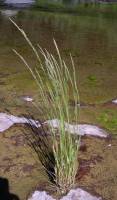|
|
|
|
Family: Poaceae
spike bentgrass
[Agrostis aenea (Trin.) Spreng., moreAgrostis alaskana Hultén, Agrostis ampla Hitchc., Agrostis asperifolia Trin., Agrostis exarata subsp. minor (Hook.) C.L.Hitchc., Agrostis exarata var. minor Hook., Agrostis exarata var. monolepis (Torr.) Hitchc., Agrostis exarata var. pacifica Vasey, Agrostis exarata var. purpurascens Hultén, Agrostis inflata Scribn., Agrostis longiligula Hitchc., Agrostis longiligula var. australis Howell, Agrostis melaleuca (Trin.) Hitchc., Agrostis microphylla var. intermedia Beetle, Agrostis microphylla var. major Vasey] |
FNA 2007, Gould 1980 Common Name: spike bentgrass Duration: Perennial Nativity: Native Lifeform: Graminoid General: Tufted perennial, sometimes rhizomatous, but not stoloniferous with stems 8-100 cm, erect or decumbent at the base, sometimes rooting at lower nodes with 3-6 nodes; sheaths smooth or slightly scabrous. Vegetative: Blades 4-15 cm long, 2-7 mm wide, flat, ligules 1.5-8 mm, dorsal surfaces scabrous, truncate to obtuse apices, lacerate to erose. Inflorescence: Contracted, spikelike panicles 5-30 cm long, 0.5-4 cm wide, oblong to lanceolate, usually dense, rarely more open, sometimes interrupted near the base, lowest node with 1-5 branches, rarely enclosed by upper sheaths at maturity; branches scabrous, ascending to appressed, spikelet bearing to or near the base, spikelets crowded, blower branches 1-2 cm; spikelets lanceolate to narrowly ovate, greenish to purplish; glumes subequal to equal, 1.5-3.5 mm, scabrous on the midvein and sometimes on the back, 1-veined with awnlike tip to 1 mm; lemmas smooth, awned or unawned, when awned awns to 3.5 mm, straight. Ecology: Found in moist soils along streams and in canyons and meadows from 4,500-10,000 ft (1372-3048 m); flowers May-October. Notes: Readily colonizes bare soil, similar to A. scabra but the dense and crowded panicle with branches bearing spikelets to the base of the spike help to identify this species. Ethnobotany: Unknown Etymology: Agrostis is from the Latin and Greek names for a type of grass, from Greek agron or agros, field or pasture, while exarata means engraved or furrowed. Synonyms: Agrostis aenea, A. alaskana, A. ampla, A. asperifolia, A. exarata var. minor, A. exarata subsp. minor, A. exarata var. monolepis, A. exarata var. monolepis, A. exarata var. pacifica, A. exarata var. purpurascens, A. loniligula, A. longiligula var. austral Editor: SBuckley, 2010 |
|
|
|



